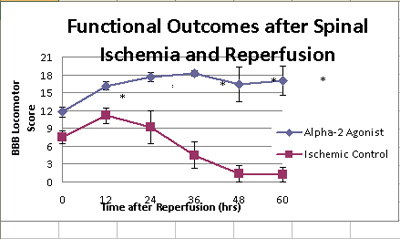Back to Annual Meeting Program
Attenuation of Spinal Cord Ischemia -Reperfusion Injury with Treatment of Alpha-2 Agonist Dexmedetomidine
Marshall T Bell, Phillip D Smith, Joseph C Cleveland, Jr., David A Fullerton, Xainzhong Meng, Michael J Weyant, Ferenc Puskas, T Brett Reece
Univeristy of Colorado, Aurora, CO
Background
Despite surgical adjuncts, delayed lower extremity paralysis remains a devastating complication following thoracic aortic surgery. Dexmedetomidine is a selective α-2a agonist commonly used for sedation in the critical care setting. It has been shown to have both neuronal and renal protective affects against ischemia-reperfusion injuries. We hypothesized that treatment with dexmedetomidine will attenuate spinal cord ischemia-reperfusion injury via inhibition of microglial activation.
Methods
Adult C57bL/6 mice underwent sternotomy followed by occlusion of the aortic arch for 4 minutes. Eight experimental mice received pretreatment with 25μg/kg of intrapeirtoneal dexmedetomidine and at 12 hour intervals following reperfusion. Eight control mice received an equivalent amount of 0.9% normal saline. Functional analysis was obtained at 12 hours intervals and scored using the Basso, Beattie and Bresnahan (BBB) score until 60 hours. All mice were euthanized at 60 hours. Their spinal cords were removed en bloc and were stained with hematoxylin and eosin to asses neuronal viability. Immunofluorescence staining with Iba-1 marker a of activated microglia was done at 12 hours after reperfusion in three mice ( 1 sham, 1 ischemic , control and 1 dexmedetomidine treated).
Results
Treated mice demonstrated preserved motor function as compared with ischemic controls (figure 1). In addition, cyto-architecture in ischemic control mice showed decreased neuronal viability by hematoxylin and eosin staining. Immunofluorescence staining of spinal cords at 12 hrs after reperfusion with Iba-1, marker of activated microglia, shows decreased activation of microglia in treatment groups.
Figure 1: BBB scores after 4 minutes of aortic occlusion. Dexmedetomidine treated mice showed significant functional improvement over ischemic controls. * Indicates P<0.05 dexmedetomidine treated versus ischemic controls.
Conclusion
Treatment of mice with alpha-2 agonist dexmedetomidine preserves motor function after spinal cord ischemia- reperfusion injury. Additionally, dexmedetomidine preserves spinal cord cyto-architecture and reduces microglia activation. In conclusion dexmedetomidine appears to attenuate spinal cord ischemia-reperfusion injury through inhibition of microglia activation. 
Back to Annual Meeting Program
